This article was first published as “Letters from Singapore to Gibraltar and Spain, 1856-60.” India Post 59 no. 2 whole no. 235 (April-June 2025). India Post is the journal of the India Study Circle for Philately.
Between 1856 and 1860, the rate on letters between Singapore and Gibraltar, or Spain via Gibraltar, was 1s10d / 15 annas for the first ½ oz. Until mid-1858, the part of the amount was collected in Singapore and the balance at Gibraltar. From then, the entire sum started being charged at the place of posting.
The 15 anna rate from Singapore, which is odd (in more than one way!), meant that covers had to be franked1 with multiple stamps of different denominations. This led to the unwitting creation of some very colourful and attractive covers.
The majority of these letters are seen addressed to Jose Matía2 at Cadiz in Spain. They generally reached him through his Gibraltar-based forwarding agent, Michael Power.
8 annas from India to Gibraltar / Spain
The 15 annas rate, at first glance, seems to be a strange and puzzling one, and ties one up in knots.
From March 1830 to August 1867, the post offices in the Straits Settlements operated under the auspices of the Indian Post. The postage rates from Straits to any particular country were the same as from India to that destination, at least until September 1861.3
Now, the prepaid rate from India to Gibraltar via Alexandria by British packets was 8 annas (i.e. 1s) first ½ oz until 31 January 1856,4 and then 4 annas (i.e. 6d) all the way to 31 March 1879.
Further, the rate from India to Spain via Alexandria and Gibraltar by British packets was likely 8 annas until 29 September 18595 and 4 annas thereafter. However, such letters sent directly to Spain could not be paid to destination.
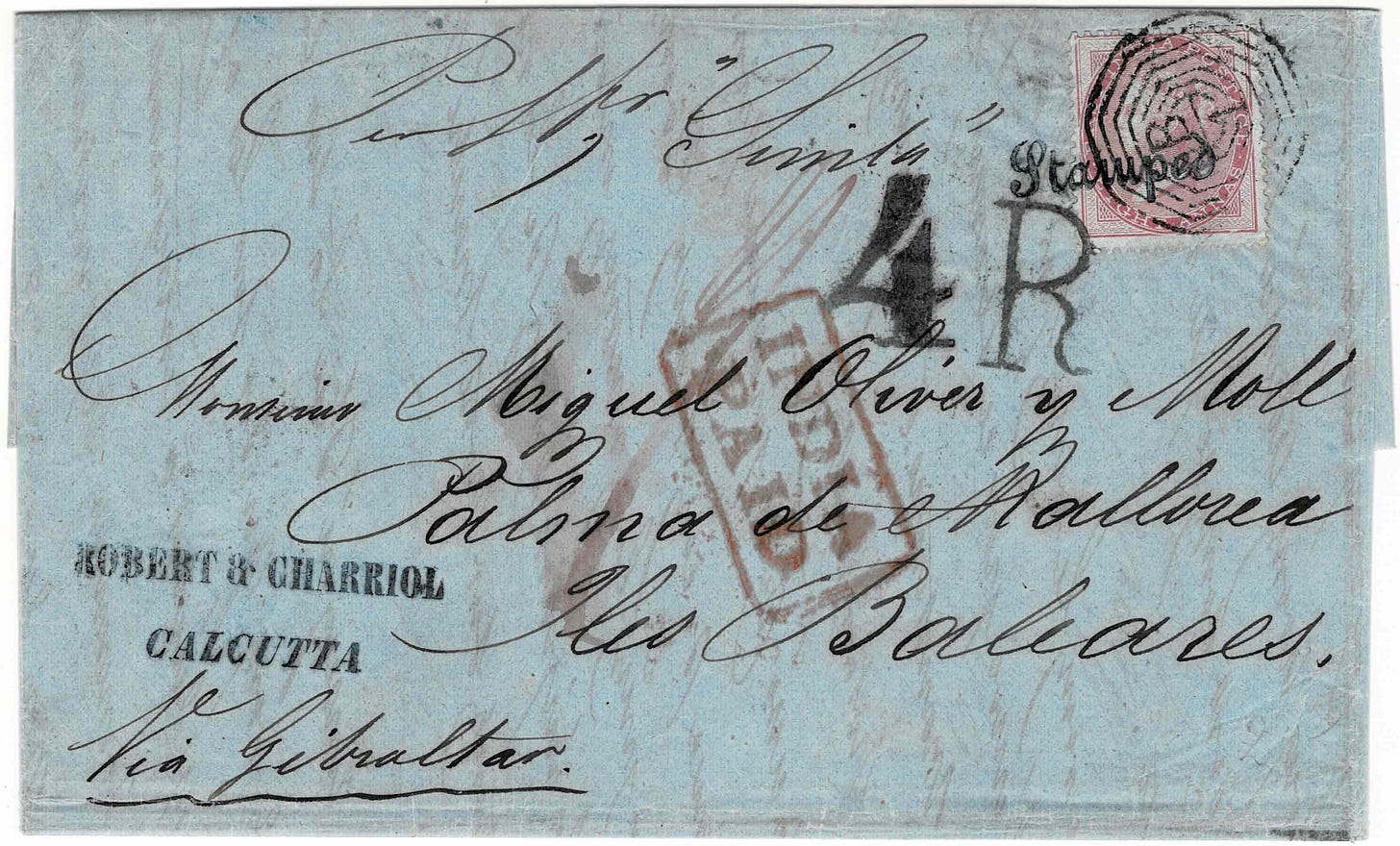
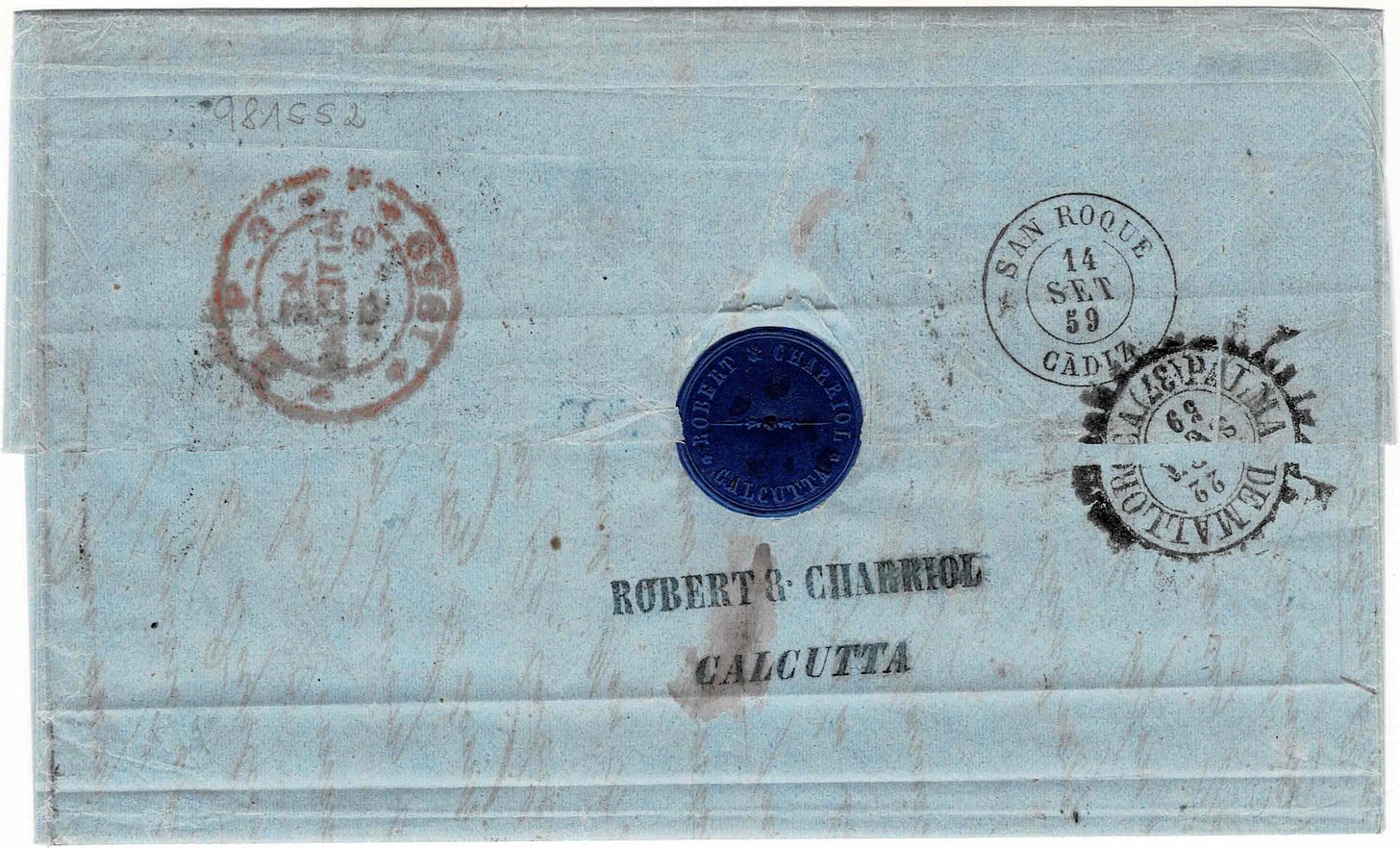
Figure 1 shows an example of the 8 anna rate from India to Spain. It is an entire letter datelined 7 August 1859 from Calcutta to Palma de Mallorca (Majorca in English), Balearic Islands, Spain. Written by the French merchant, Robert & Charriol, it was stamped 8 annas, and hence must have weighed less than or equal to ½ oz.
The letter reached Spain via Gibraltar. On delivery, ‘4R’ for postage of 4 reales (Real de Vellon) on incoming letters weighing 4 adarmes (or ¼ oz) was recovered.
Authority for the 15 annas / 1s10d Rate
Coming back to Singapore, why did its post office charge 15 annas and not 8 annas?
Let us understand this one step at a time.
A British Treasury Warrant dated 19 September 1855 reduced the packet rate between any two British ports (inter-colonial rate), which included Singapore and Gibraltar, with effect from 1 January 1856.6
The London GPO sent a letter signed by one J. Tilley and dated 31 October 1855 to the Singapore Post Office. Published in The Singapore Free Press and Mercantile Advertiser of 3 January 1856, it affirmed that the reduced rate applied between Singapore and Gibraltar.
I am directed by the Post Master General to acquaint you, for your information and guidance that, on and from 1st January 1856, the Packet rate of postage upon letters transmitted by British Packet between Singapore and any other port in India or a port in any other British Colony, without passing through the United Kingdom, will be reduced from one shilling to four pence the half ounce.
The reduced rate of four pence will apply not only to letters between Singapore and the several British possessions in the East Indies, including Hong Kong, Ceylon and Mauritius, but also to letters between Singapore and the Colonies of Malta, Gibraltar, and the Ionian Islands.
A like reduction from one shilling to four pence will at the same time take effect in the rate of postage upon letters conveyed by British Packet between Singapore and any Foreign Port, with the exception of a port in Egypt.
(Apart from the 4d packet postage, 1d each was collected for the benefit of the sending and receiving country/colony. In other words, the total prepaid rate to destination was 6d for ½ oz weight.)
The joy felt by correspondents between Singapore and Gibraltar/Spain was, however, short-lived!
The Packet Agent at Gibraltar, Edmund Creswell, wrote to London on 14 December 1855 that mails between Gibraltar and Hong Kong, or Singapore, mainly consisted of Spanish correspondence in transit between Spain and Philippines. He recommended that the old rate of 1s10d remain in place (Garcia and Proud 1998, p.193 and 444).
This was accepted and another warrant dated 31 December 1855, and effective 1 January 1856, was issued. The warrant said (emphasis mine):
Now we, the Commissioners of Her Majesty's Treasury, in exercise of the powers vested in us, in and by the said recited Act, and of all other powers enabling us in this behalf, do by this Warrant (under the hands of two of us the said Commissioners by the authority of the Statute in that case made and provided), order and direct that on every letter not exceeding half an ounce in weight transmitted by the post direct by British packet-boat, between Gibraltar and Hong Kong, or Singapore, without passing through the United Kingdom, there shall be charged and taken, in lieu of any rates of postage heretofore chargeable on such letters, or which would be chargeable thereon, under or by virtue of the said recited Warrants, or either of them, a uniform British rate of one shilling and ten pence (in which the Red Sea or Persian Gulf packet rate is included).
Note that 1s10d composed of 1s being the ‘Red Sea’ rate from the East to Alexandria via Egypt and 10d for the ‘Mediterranean’ packet rate applicable for the Alexandria-Gibraltar leg.
Postal History
In this article, I will be looking at letters from Singapore only. I will cover partly paid and fully paid letters.
Partly Paid 8 annas to Alexandria
Subsequent to the aforesaid warrant dated 31 December 1855, a Singapore Postal Notice dated 29 February 1856 announced reduced rates to Great Britain. Published in The Singapore Free Press and Mercantile Advertiser of 6 March 1856, it said among other things:
That the former rate of one shilling per half ounce on all letters passing between Singapore and Gibraltar will hereafter be maintained, as the reduced rate of Four Pence does not apply to the Correspondence in question.
This notice shows that, for the first two years and some months, letters sent from Singapore had to prepay 8 annas (i.e. 1s) only with the balance 10d being collected at Gibraltar on delivery.
Figure 2 is an entire letter from Singapore to Cadiz, Spain. The double oval blue handstamp on the front is of the sender, Rautenberg, Schmidt & Co. Posted on 22 March 1858, it partly paid 8 annas for the journey to Alexandria.


There are no Spanish posmarks, which makes it clear that the letter was delivered to a forwarding agent in Gibraltar; the Post Office there knew who Matia’s agent was (most likely M. Power).
An additional 10d (marked ‘10’ in black crayon) was due from the recipient for the Alexandria-Gibraltar leg. The agent paid the postage due and sent the letter to Sr. (Senor) D. (Don) Jose Matia under cover.
Fully Paid 15 annas to Gibraltar
With effect from 28 May 1858, Creswell, by now the Postmaster of the Gibraltar Post Office,7 was informed by London that the full rate of 1s10d was to be prepaid on posting (Garcia and Proud 1998, p.444).
A similar direction must have been given to the Singapore Post Office. From sometime in mid-1858, the exact date is not known, the rate from Singapore to Gibraltar became 15 annas on dispatch (Figure 3).
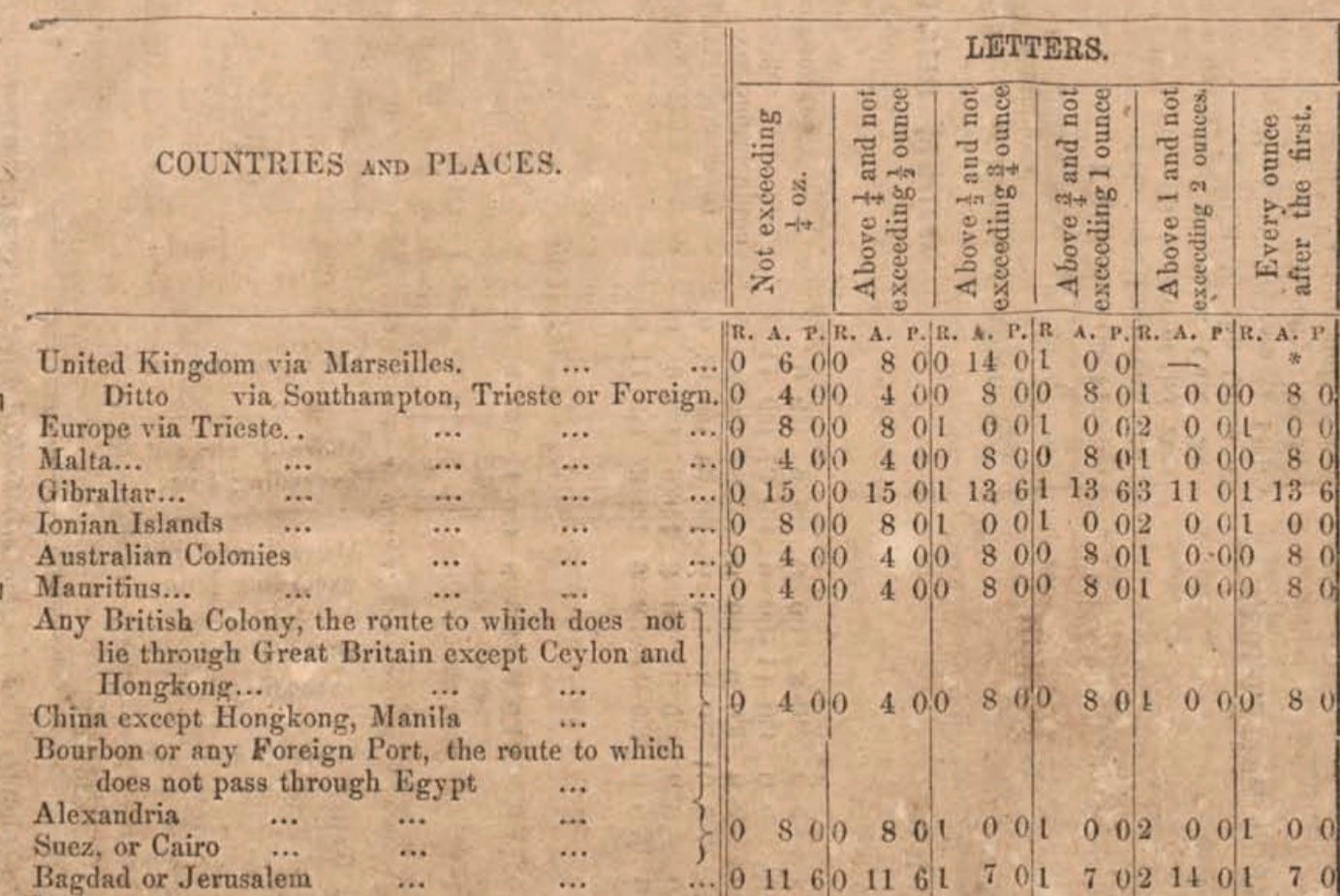
In terms of exchange rates, 1s10d was actually equal to 14 annas 8 pies. The Singapore Post Office rounded it up 4 pies to 15 annas most likely since an 8 pies stamp was not available until 1860.8
The first Singapore to Gibraltar/Spain letter with the 15 annas rate that I have been able to identify is an entire from 14 July 1858;9 all other examples are from 1859.
Figure 4 illustrates an entire letter datelined 11 May 1859 from Singapore to Cadiz which was paid all the way to Gibraltar. The sender can be figured from the red seal on the rear which reads ‘MIDDLETON HARRISON & Co. / SINGAPORE’.
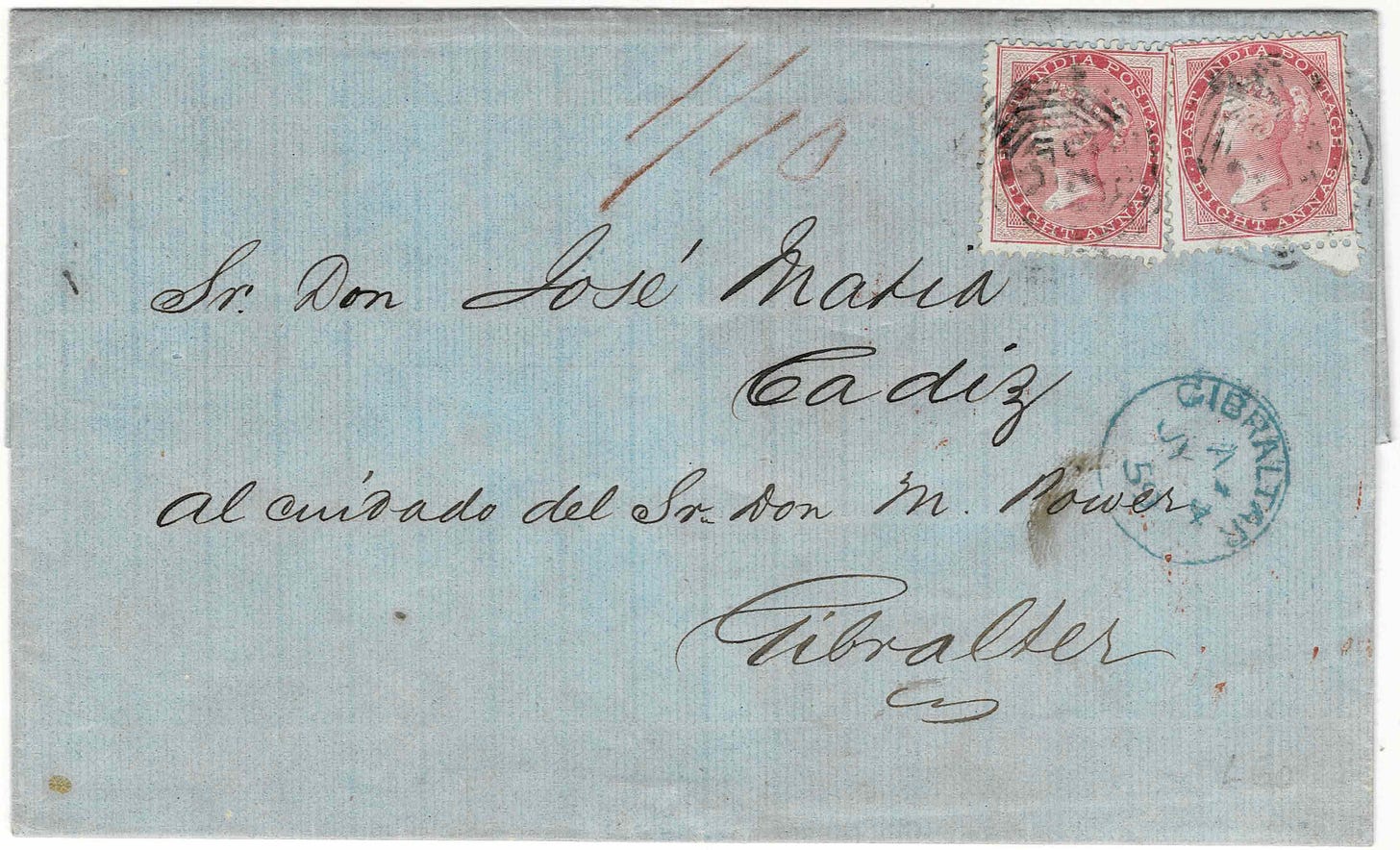
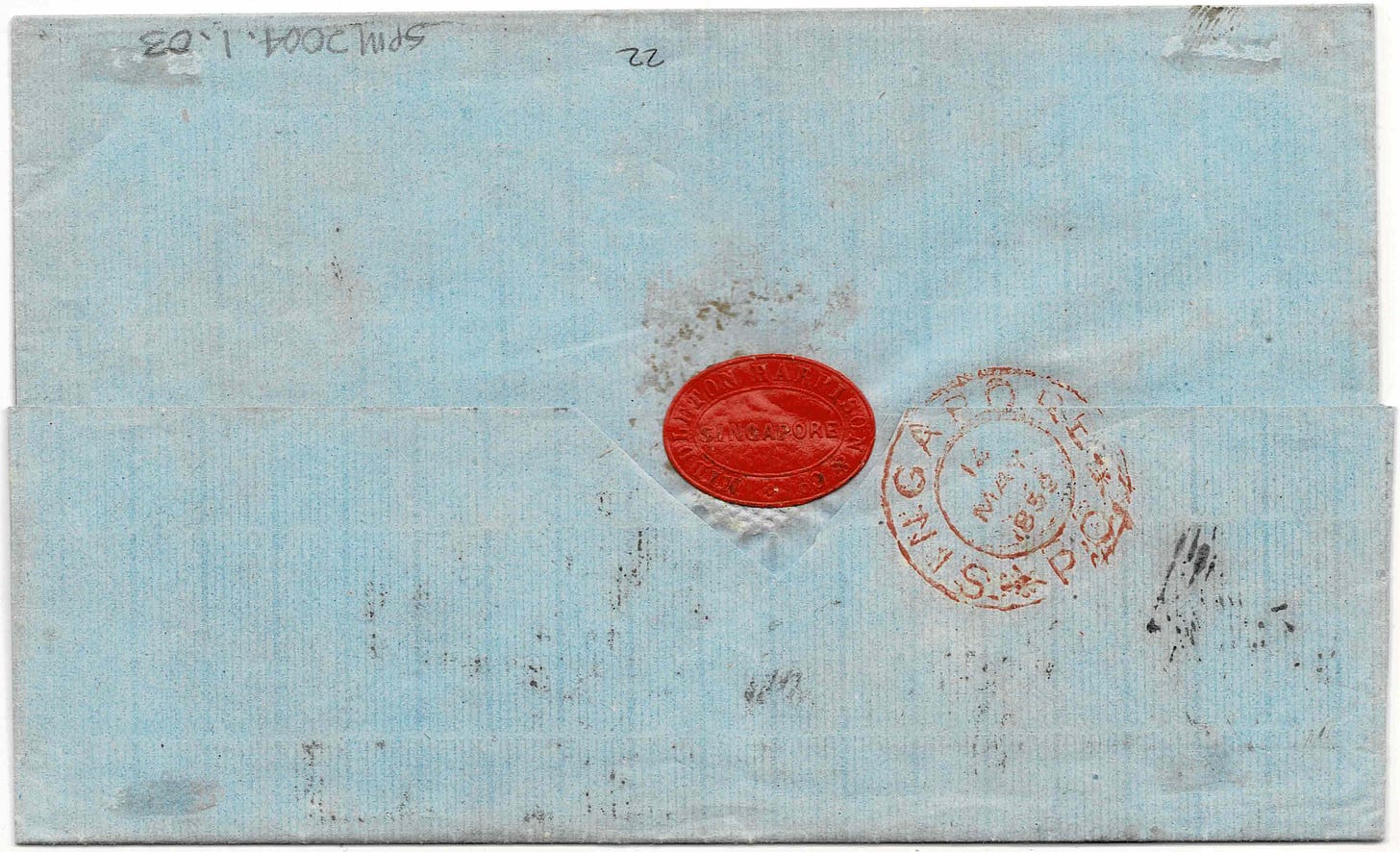
The sender overpaid by franking the letter 16 annas (or 2s); perhaps stamps of lower denominations were not immediately available.10 As evidenced by the red ‘1/10’ accountancy notation, the Singapore Post Office credited the London GPO 1s10d, which was the rate specified by the above-mentioned warrant.11
The letter was delivered to the care of (‘al cuidado del’ in Spanish) Gibraltar-based M. (Michael) Power on 4 July. He forwarded the letter to Jose Matia; docketing inside shows it reached the latter on 6 July.
A very interesting thing to note is that this letter was board the P&O Alma, when she wrecked in the Red Sea on 12 June (Figure 5). All mails were saved and they did not suffer in the slight. Hence, no wreck cachet was prepared to be applied on such letters. They only be identified by the dates on them.
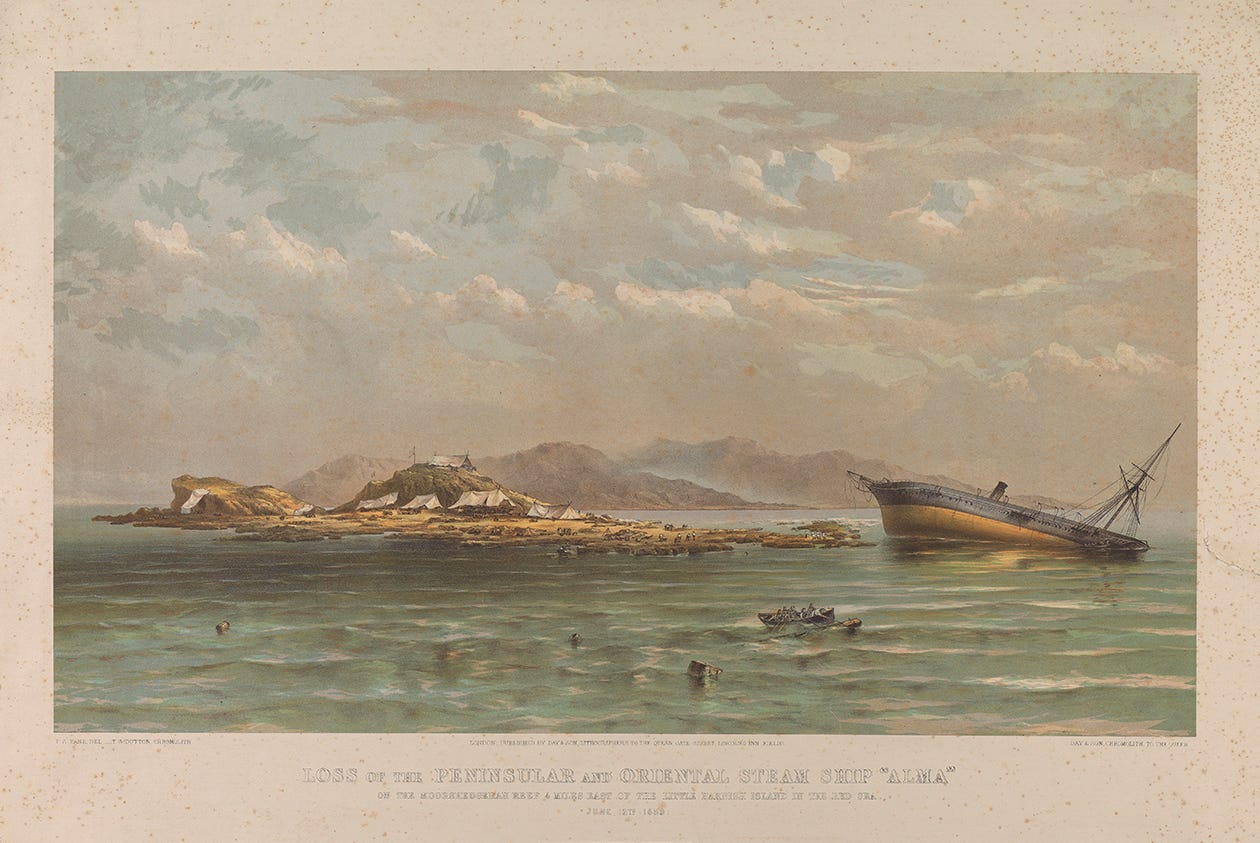
I have written on this wreck earlier in the journal India Post (see References below) but I was not aware of this letter then. This is the first letter from the Straits that I know of which was saved from this wreck.
Figure 6 shows a twice-forwarded letter datelined 13 November 1859 which is correctly paid 15 annas. There are some interesting aspects to this letter:
It is the only one known not written from Singapore
It has the (joint) second highest franking with five stamps affixed; the most on this route in this time period is a letter with six stamps
It is the latest known letter with the 15 anna rate
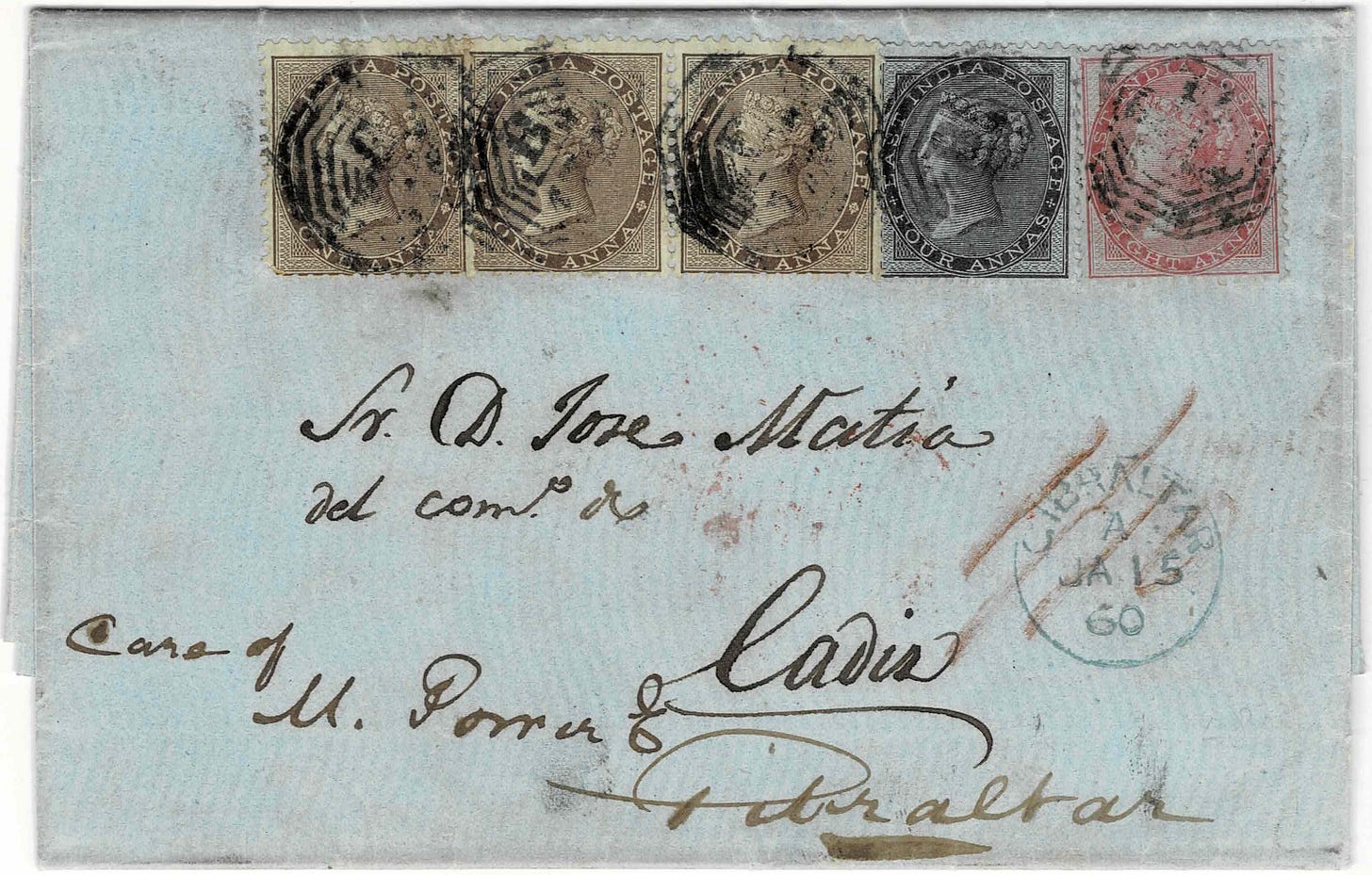

Initially, I was under the impression that the letter, which is in Spanish, was written from Manila in Spanish Philippines. This I based on the last auction house description in which this letter appeared, which said, among other things: “This is the only recorded cover originating in Manila using Indian stamps and sent thru the Singapore post office to Gibraltar.”
However, a perusal of the inside shows that it was written from Rada de Anjer (or Angier) in the Dutch East Indies and not Manila (Figure 7).
A rephrased correct description would read: “This is the only recorded cover originating in the Dutch East Indies using Indian stamps and sent through the Singapore post office to Gibraltar.”
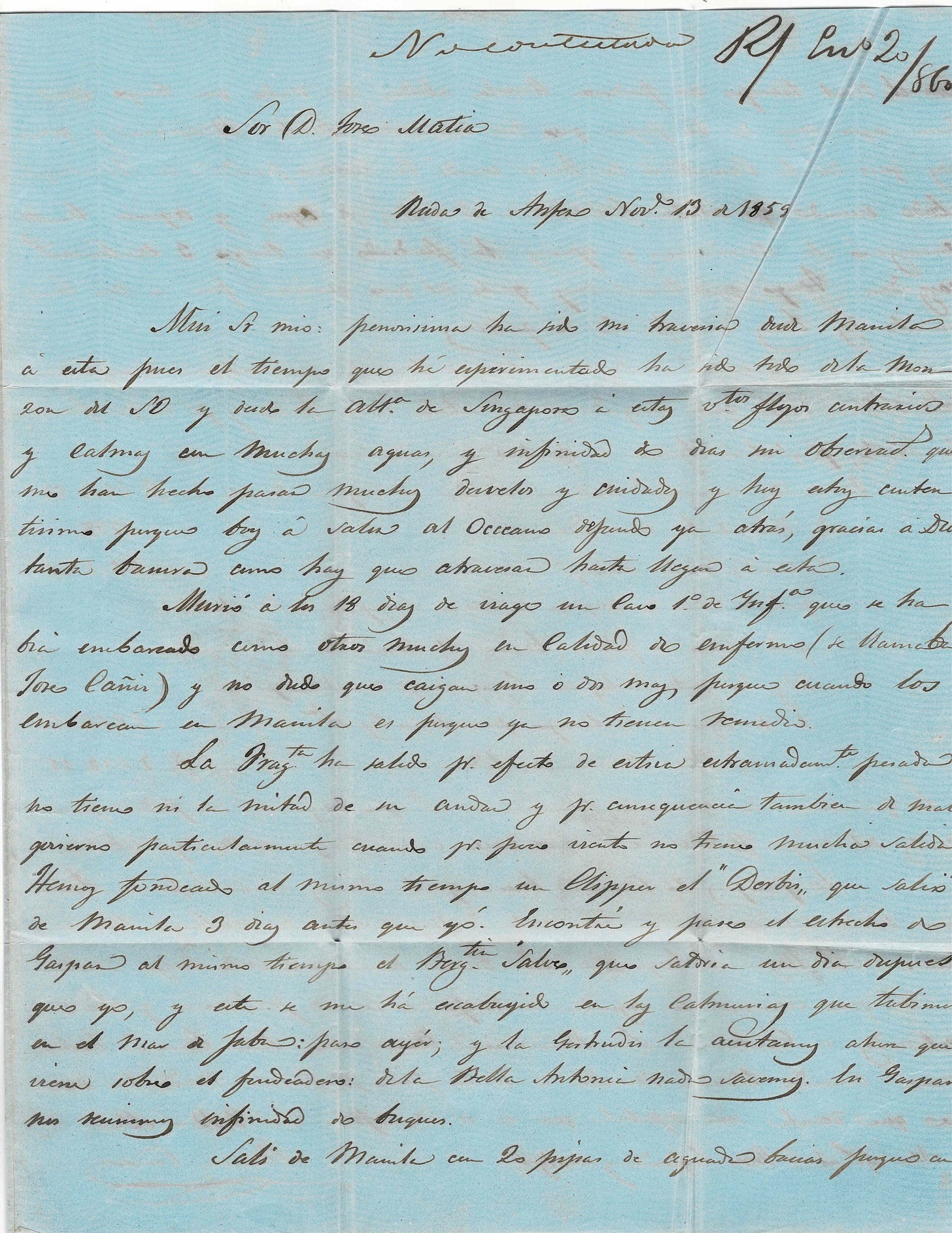
The sender had left Manila on a ship and reached Anjer, where he wrote this letter (Figure 8). Through the favour of someone on the way to Singapore,12 the letter reached the forwarding agent, Middleton, Harrison & Co., sometime in end-November or beginning-December 1859.
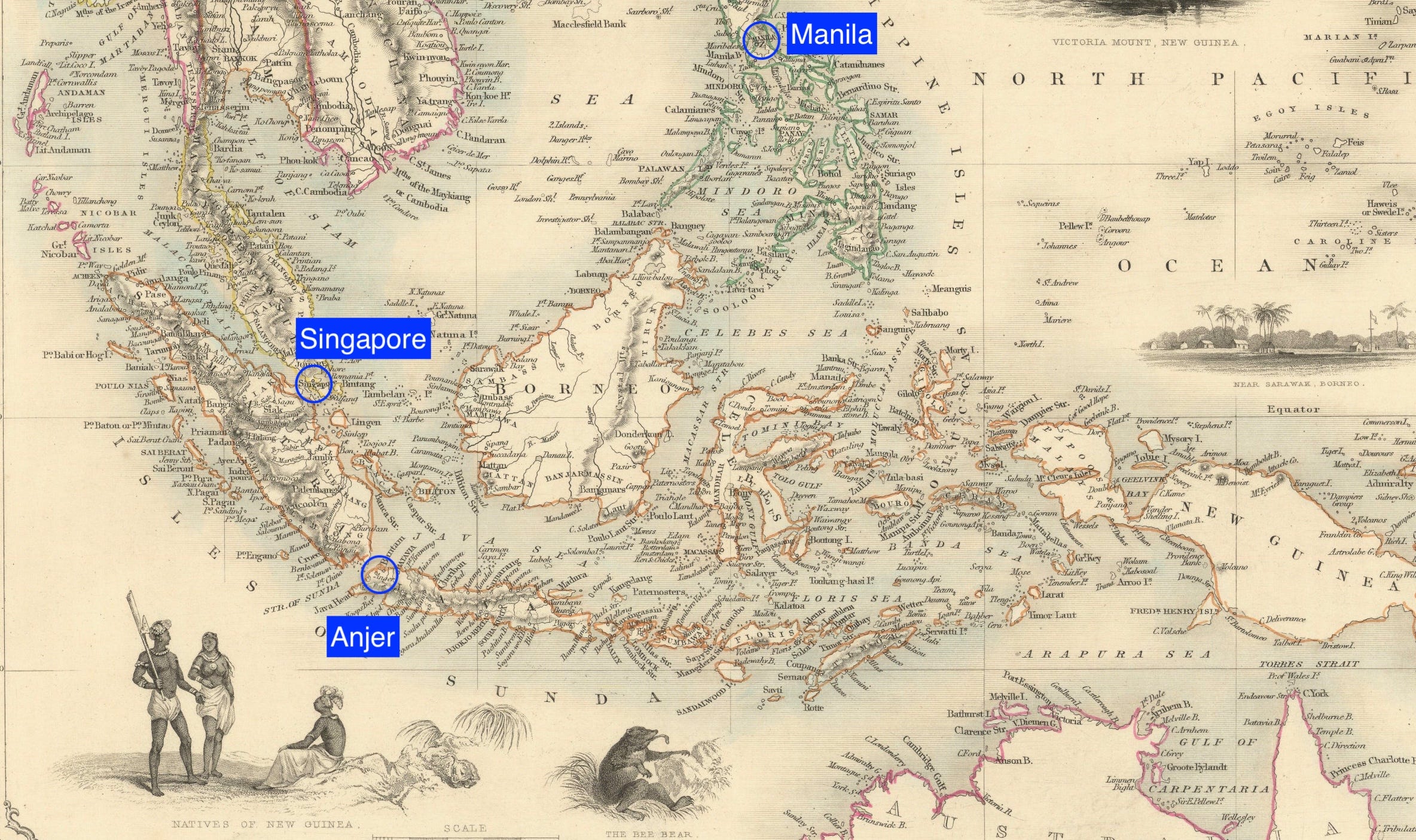
Who franked the letter with 15 annas of stamps? Perhaps the sender had a small stock of Indian stamps with him. Or, more likely, the agent at Singapore affixed them before posting the letter, and later debited the sender’s account with itself.
As before, the red crayon ‘1/10’ indicated a credit of 1s10d by the Singapore Post Office to the London GPO.
Arriving at Gibraltar on 15 January 1860, it was again forwarded by M. Power to Cadiz (the ‘Care of / M. Power E (for Esquire) / Gibraltar’ in a different ink and handwriting was probably added by the forwarding agent).
End of the 15 anna / 1s10d Rate
A Treasury Warrant dated 10 September 1860 and effective 1 December reduced the rate between Gibraltar and Hong Kong, or Singapore to 1s.13
Shortly thereafter, on 19 November 1860, the Singapore Post Office issued a notice under the hand of its postmaster, William Cuppage. Published in the Straits Government Gazette14 of 23 November 1860, it said:
By a Treasury Warrant dated the 10th September 1860, the rate of postage upon Letters conveyed by packet between Singapore and Gibraltar has been reduced from One Shilling and Ten Pence to One Shilling the half ounce letter. This reduction of postage is to take effect on and from the 1st December 1860.
This brought an end to the 15 annas rate and the associated covers that have proved so attractive to postal history collectors.
Acknowledgements: Thank you Richard Garcia and Geoffrey Lewis for helping make this a better article. Michael Waugh for his encouraging remarks. Feedback is very welcome; please send your comments to abbh [at] hotmail.com.
References
Bhuwalka, Abhishek. “Wreck of the SS Alma, June 1859.” India Post 55 (4): 148-152.
Garcia, Richard J.M., and Edward B. Proud. 1998. The Postal History of Gibraltar. Heathfield, East Sussex: Proud-Bailey Co. Ltd.
Kirk, R. 1982. The P&O Lines to the Far East. Vol. 2. 4 vols. British Maritime Postal History. Heathfield, East Sussex: Proud-Bailey Co. Ltd.
Martin, D. R., and Colonel Neil Blair. 1975. Overseas Letter Postage from India 1854-1876. London: Robson Lowe Ltd.
Peterson, Don, and Geoffrey Lewis. 2000. Postal History of the Spanish Philippines 1565-1898. Washington, D. C.: Don Peterson.
Proud, Edward. 2000. The Postal History of Malaya Vol 1. 2nd ed. Vol. I. III vols. Heathfield, East Sussex: Proud-Bailey Co. Ltd.
———. 2004. The Postal History of Hong Kong. Heathfield, East Sussex: Proud-Bailey Co. Ltd.
Rowe, Kenneth. 1996. The Postal History and Markings of the Forwarding Agents. 4th ed. Louisville, Kentucky: Leonard H. Hartmann.
Smith, Max. 2015. “Accountancy Notations on Mail between India and G.B. 1854-1856.” India Post 49 (2): 50-61.
Indian postal regulations specified that mails to Gibraltar had to be necessarily prepaid and further, prepaid in stamps. Indian stamps were used at Singapore from their introduction on 1 October 1854 until the Straits became a Crown Colony on 1 September 1867.
José Matía Calvo (1806-1871), was born in Llodio on 6 June 1806. In 1821 he was placed in Manila, dedicated to the trade generated around the Philippine Company. After several years he founded the shipping company ‘Matía, Menchacatorre y Cía’. In 1841 he moved to Cádiz where he established his Headquarters under the name of José Matía, from where, with his fleet of frigates, he operated commercially with the Philippines.
Owing to a severe depression, the Governor of Hong Kong tried to have the China Line service limited to once a month (Kirk 1982, p.54). In May 1861, the Second Monthly Mail to the Straits and China was discontinued with effect from July. A tremendous outcry by the London merchants led to the service being hurriedly re-established from August. However, “the revenue derived from the correspondence conveyed by the line of packets” between Point de Galle and Shanghai via Penang, Singapore, and Hong Kong was “insufficient to cover the cost of this double service”. Hence, a Treasury Warrant dated 2 August increased the rate from the Straits to GB and British colonies and foreign countries through GB by 4 annas. Rates to other places, for example countries in Europe, were not tinkered with and remained the same as that from India to those places.
The London GPO issued the relevant postal notice on the increase in rates on 3 August 1861. The Straits Times of 21 September carries a report mentioning that the Singapore Post Office has issued a circular on the increased rates of postage; unfortunately, the circular itself cannot be found. So, while Martin and Blair (1975, p.34) mention that the revised rates came into effect from 2 January 1862, they are likely incorrect.
Treasury Warrant dated 19 September 1855, which I discuss a few paragraphs later, was the basis for this new reduced rate. While the warrant was effective 1 January 1855, it took time in being communicated to India (through the Court of Directors of the East India Company) and was put into force from 1 February only.
A Post Office Notice dated 30 September 1859 issued by C.K. Dove, the Post-Master General of Bengal said:
Under instructions from the London General Post Office, letters for Spain will in future be sent in the Mails for Gibraltar, and they will be charged with Steam Postage according to the following rate:-
Not Exceeding ½ ounce 6d or 4 annas.
Exceeding ½ and not exceeding 1 ounce, 1 shilling or 8 annas and so on, 1 shilling or 8 annas for every additional ounce or any fraction of an ounce.
The payment of Steam Postage upon all such letters is optional, but whenever they may be posted in the Moffusil the Indian Inland Postage must be prepaid by Stamps.
The warrant read:
Now we, the Commissioners of Her Majesty's Treasury, in exercise of the powers vested in us in and by the said recited Act, and of all other powers enabling us in this behalf, do by this Warrant (under the, hands of two of us the said Commissioners by the authority of the statute in that case made, and provided), order and direct that on every letter not exceeding half an ounce in weight transmitted by the post direct by British packet-boat between any ports in the British colonies, or between any ports in the British colonies and any foreign port (not in any such cases passing through the United Kingdom) there shall be charged and taken (in lieu of the rates heretofore chargeable for the sea conveyance of such letters) a packet postage of four pence.
On 1 January 1857, the Packet Agency and the Overland Post Office were amalgamated to form the Gibraltar Post Office. The entire postal service in Gibraltar then came under the control of the Postmaster General in London and Creswell was appointed the Postmaster.
The Indian currency was 12 pies to an anna and 16 annas to a Rupee. For double letters weighing between ½ and 1 oz, the rate was more exactly calculated as 1 Rupee 13 annas 6 pies i.e. double of 14 annas 8 pies was 29 annas 4 pies. Again, due to lack of an 8 pies stamp, the Singapore Post Office rounded the double weight rate up 2 pies. No such double weight covers from this period are known to me.
This letter appeared as lot no. 32 the Tan Ah Ee sale of ‘India Used in the Straits Settlements’ on 2 August 2019 in Spink Singapore. It was ex Dr. Chua Eu Tiong whose sale took place on 2-3 July 2005.
Certain auction descriptions (for example lot no. 69 in the V.T. Nathan sale of Straits Settlements held 16 April 2009) mention that the 15 annas rate was effective 24 July 1858. The Tan Ah Ee letter certainly puts paid to that assertion. I presume that the describers referred to Martin & Blair’s book, wherein the latter mention a host of rates to overseas countries under this date. While this is true, the authors were only reproducing a table of postage rates found in the Calcutta Gazette of this date; it does not mean that 24 July was the start date of these foreign rates.
Between 1857 and 1862, covers from the Straits are known with bisected stamps on them. The reason given is that certain values were in shortage. Less than 60 covers are known; the Tan Ah Ee sale catalogue of 2019 records ten in the Royal Philatelic Collection and another 47 elsewhere. It is interesting that none of the 47 are to Gibraltar or Spain.
Unlike letters sent to other places where the sending Post Office retained 1d, in the case of letters between Singapore and Gibraltar, the entire 1s10d had to be credited to British Post Office and no sum accrued to the Singapore Post Office (apart from any negligible sum arising from rounding up the rate).
The best definition of a forwarding agent can be found in Rowe (1996, p.ix). He says that a forwarding agent is:
A person, or firm, who undertakes to see that the goods or correspondence of another are transported without himself acting as the carrier.
Since the person taking the letter to Singapore was the carrier, he cannot be considered a forwarding agent. Hence I say that this is a twice and not thrice-forwarded letter.
The warrant said:
And we do further order and direct, that on every letter not exceeding half an ounce in weight, transmitted by the post direct by British packet-boat, between Gibraltar and Hong Kong, or Singapore, without passing through the United Kingdom, there shall be charged and taken in lieu of any rates of postage heretofore chargeable on such letters, a uniform British rate of one shilling (in which the Red Sea or Persian Gulf packet, rate is included).
The Straits Government Gazette was first published in 1858. Unfortunately, some of the early volumes (1, 4-7, and 9 for example) are missing from the National Library of Singapore’s online collections.





Wow! What a fantastic article! Thanks for sharing. It has been a lot of work to write this article. Thank you.